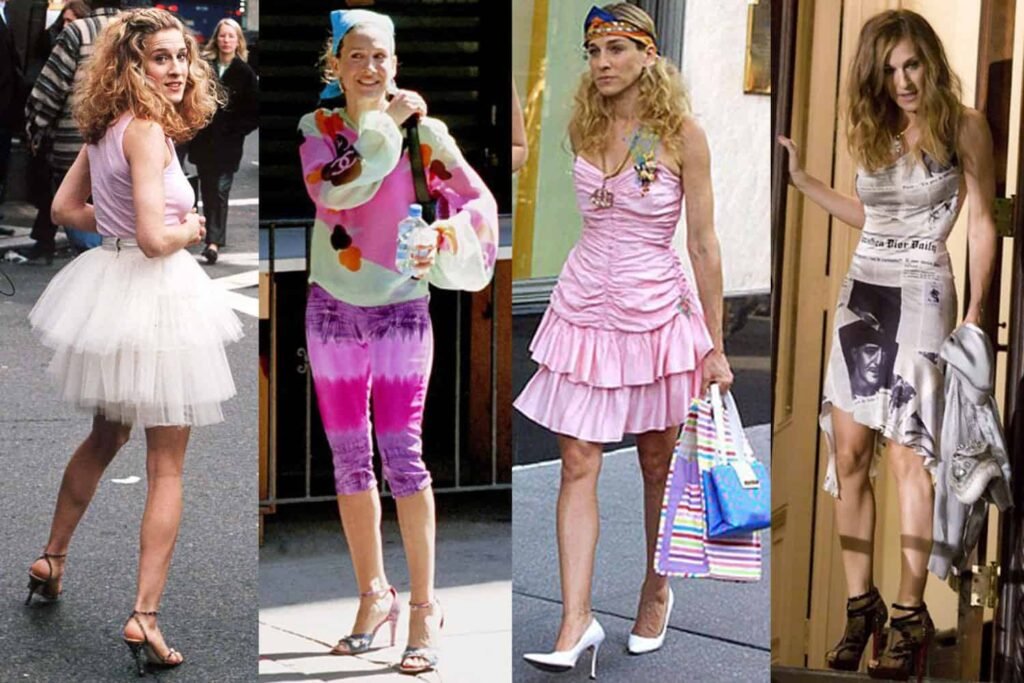Few fashion moments have become as instantly recognizable or endlessly discussed as the Sex and the City dress. Immortalized by Carrie Bradshaw—played by Sarah Jessica Parker—this seemingly simple garment evolved into a cultural icon, symbolizing everything from liberated femininity to the excesses of early 2000s fashion. But beneath the glitz and glam lies a story of design intrigue and disputed legacy that continues to stir conversation today.
The Rise of an Icon
Carrie Bradshaw’s Fashion Legacy
When Sex and the City debuted in the late ’90s, it revolutionized not only the way women were portrayed on television but also how fashion was integrated into storytelling. Carrie Bradshaw, a columnist with a taste for Manolos and vintage finds, became a global fashion muse. Among her many standout looks, one dress, in particular, stood out—the slip dress she wore in multiple pivotal scenes.
This Sex and the City dress quickly resonated with fans. It was minimalist yet sensual, understated yet unforgettable. That contrast made it a symbol of Carrie herself: complex, stylish, and always a little rebellious.
The First Appearance and Instant Obsession
The now-iconic dress first appeared in the show’s third season. Worn during a tense reunion with Mr. Big, the slinky, pale pink slip dress felt raw and intimate, emotionally charged yet effortlessly cool. Its popularity skyrocketed. Media outlets praised it. Fashion blogs dissected it. Soon, everyone wanted “the Carrie dress.”
Social Media and Nostalgic Resurgence
Decades later, the Sex and the City dress still trends on Instagram, TikTok, and Pinterest. It has inspired countless replicas and fashion hauls. Gen Z and Millennials alike idolize it, whether through vintage shopping or rewatching SATC episodes. Its lasting power in digital culture speaks volumes about its symbolic grip.
What Makes the Dress So Memorable?
Designer Origins and Aesthetic Impact
While the Sex and the City dress may appear simple, its construction is anything but. Designed by Patricia Field—the show’s legendary costume designer—it captures a perfect balance of softness and sensuality. The bias cut, delicate straps, and silk fabric made it feel like a second skin. It was casual yet cinematic.
But here’s where things get complicated: some reports suggest that the dress was not custom-made, but a vintage piece found by Field. Over the years, various fashion insiders have claimed inspiration—or even credit—for its design, leading to disputes over its true origin.
Style Influence and Global Reproduction
The ripple effect was immediate. Fast fashion retailers began producing affordable versions, while luxury brands reimagined it with their twists. From runways in Paris to department stores in New York, the Sex and the City dress became the template for the 2000s slip trend—one that has made a strong comeback in recent years.
The Controversial Origins
Design Disputes and Attribution Issues
One of the major controversies surrounding the Sex and the City dress is tied to its authorship. Was it a carefully crafted design from the start, or an off-the-rack find elevated to icon status through storytelling? Patricia Field has often said she sourced many outfits from thrift stores and lesser-known designers. As the dress gained fame, so did questions about proper credit and recognition.
Cultural and Ethical Concerns
In today’s climate of increasing awareness around ethical fashion, the conversation about the Sex and the City dress also touches on broader issues: Who gets the credit? Was the original designer ever acknowledged? Did the show profit off the work of someone never paid or praised? These discussions are vital, especially as fashion history continues to be reexamined through a modern, more inclusive lens.
Why the Dress Still Matters
A Symbol of Fashion Empowerment—or Consumerism?
For some, the Sex and the City dress is a symbol of female empowerment—a moment where a woman’s wardrobe was as complex and independent as her storyline. For others, it represents consumerism and material aspiration: the fantasy of buying confidence and identity through high fashion. As with much of SATC, the dress embodies this tension.
Legacy in TV Fashion History
Few garments have earned their place in pop culture like this one. Alongside Rachel Green’s plaid skirt or Blair Waldorf’s headbands, the Sex and the City dress holds a permanent spot in the television fashion hall of fame.
Conclusion
The Sex and the City dress is more than just a piece of fabric—it’s a conversation starter, a nostalgic memory, and a case study of how fashion, media, and meaning intertwine. Its cult status is well-deserved, but its story is also layered with mystery and complexity. As we continue to rewatch and reevaluate, one thing is clear: no dress has ever said so much with so little.
Don’t Miss Out! Get the Latest News, Tips, and Updates from Us!
